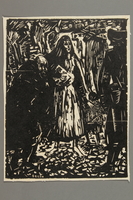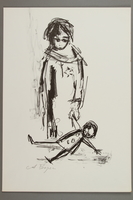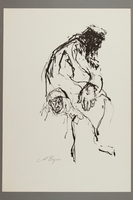Overview
- Brief Narrative
- Lithograph created from a drawing done by Alexander Bogen, following the liberation of the Vilna, Lithuania, region. It depicts an armed partisan during World War II. Bogen was an art student in Vilna in 1941 when Germany invaded and occupied Lithuania. Imprisoned in the Vilna ghetto, he sketched scenes of the life of his fellow Jews. “An artist doomed to death,” he said in later years, “recording and so preserving those doomed to death.” In 1943, he escaped the ghetto and joined the partisans in the Naroch Forest in Belarussia, who carried out sabotage and other actions against the occupying German military. He joined the all-Jewish Nekhama (Revenge) partisan brigade, and reentered the Vilna ghetto to help underground fighters escape as it was being liquidated by the Germans. When Lithuania was liberated in 1944 by Soviet forces, he returned to Vilna and resumed his studies.
- Artwork Title
- In attack
- Date
-
creation:
1944
- Geography
-
depiction:
Naroch Forest;
Belarus
- Credit Line
- United States Holocaust Memorial Museum Collection, Gift of Alexander Bogen
- Signature
- front, lower left, pencil : A. Bogen / 43
- Contributor
-
Subject:
Alexander Bogen
Artist: Alexander Bogen
- Biography
-
Alexander Katzenbogen was born January 24, 1916, in Tartu, Estonia. His parents were both doctors. His father was from a secular Jewish background; his mother was the daughter of Rabbi Tuvia Lobitzki of Volkovysk, Poland (now in Belarus). When Alexander was two years old, the family moved to Vilna, Lithuania. The atmosphere in the home as he was growing up was liberal. His parents were socialists; he was a member of the Socialist-Zionist youth group Hashomer Hatzair. He married Rachel Shachor (b. 1914).
In 1941, Alexander was studying art at the University of Vilna. At that time, Vilna was under Soviet rule. On June 22, Germany invaded the Soviet Union and German planes bombed Vilna. Alexander and Rachel joined a large exodus from the city on foot toward the east. They got as far as Minsk, a distance of over a hundred miles, before German military activity forced them to turn back and return to Vilna. The journey east and then back to the west took months. Along the way, Alexander began sketching what he saw of the suffering of his fellow Jews under the new German occupation.
Alexander and Rachel were among the Jews confined to the Vilna ghetto, where Alexander joined the FPO, the Fareynikte Partizaner Organizatsye (United Partisan Organization), an underground organization inside the ghetto with paramilitary aspirations. He had the code name Shura. In addition to activities in the FPO, he sketched images of life in the ghetto. There was a debate within the FPO about whether to make a last stand against the Germans inside the ghetto, or to join partisans on the outside in the ongoing fight against the German occupation of the region. On July 29, 1943, a small band of FPO members, Alexander among them, escaped the ghetto and joined the Voroshilov brigade of partisans in the Naroch Forest, 60 miles to the east.
The majority of the partisans there were non-Jewish Russians. An all-Jewish unit was formed, called Nekhamah (Revenge). Alexander and other members of the unit distinguished themselves in paramilitary actions. Even under those conditions, Alexander sketched, using scraps of packing paper and charcoal made by burning dry branches. He sketched his fellow partisans, sometimes doing so as he and they were going into battle. In later years, he recalled, “Each man when he is standing face to face with cruel danger, with death, reacts in his way. The artist reacts with his means. This is his protest! This is my means! He reacts in an artistic way. This is his weapon.” The partisans produced a small newspaper on a mobile press. Alexander prepared woodcuts for the publication using his pen-knife.
At the beginning of September, 1943, a plan was formed for Alexander and a band of Jewish partisans to return to Vilna to infiltrate the ghetto and help potential fighters escape. The journey from the Naroch forest back to Vilna took a week. Along the way, Alexander’s group took food from peasants, sometimes at gunpoint. Once inside the ghetto, he reestablished contact with the FPO. German troops were in the final phase of liquidating the ghetto. Again, Alexander sketched what he observed. “We saw forsaken children. We saw people being taken to slaughter. I could not let my pencil fall. To tell about this to a world that was uninformed--to be creative in the situation of the Holocaust, this is also a protest.” On September 11, he helped lead 150 FPO members in an escape from the ghetto and on the journey to the Naroch Forest. His wife, Rachel, and her mother were also among the escapees.
Anti-Semitism by the Russian partisans made the position of the Jews among them difficult. Alexander was removed from military action and spent his time recording the history of the partisans by sketching their way of life. After the war, Alexander and Rachel returned to Vilna. Alexander returned to his studies and graduated in 1947, then he and his wife emigrated to Poland, where he became an award-winning artist. They had a son, Michael. In 1951, they made aliyah to Israel. During his career as an artist there, Alexander frequently used the subjects he had sketched during the war. Rachel died in 1998 at age 83 (or 84?), Alexander on October 20, 2010 at age 94.
Physical Details
- Classification
-
Art
- Category
-
Prints
- Object Type
-
Lithographs (aat)
- Physical Description
- Lithograph in black ink on rectangular, white colored paper. It depicts a man standing in three-quarter rear profile, pointing a raised rifle, and wearing a fur hat and heavy belted coat. Artist’s signature in lower left. Back has handwritten numbers.
- Dimensions
- overall: Height: 19.625 inches (49.848 cm) | Width: 13.750 inches (34.925 cm)
- Materials
- overall : paper, ink, graphite
- Inscription
- back, lower right corner, pencil : 50-114
Rights & Restrictions
- Conditions on Access
- No restrictions on access
- Conditions on Use
- Restrictions on use
Keywords & Subjects
- Topical Term
- Guerrillas as artists--Belarus. Guerrillas as artists--Lithuania. Holocaust, Jewish (1939-1945), in art. World War, 1939-1945--Jewish resistance--Belarus. World War, 1939-1945--Jewish resistance--Lithuania. World War, 1939-1945--Underground movements--Personal narratives.
- Personal Name
- Bogen, Alexander.
Administrative Notes
- Legal Status
- Permanent Collection
- Provenance
- The lithograph was donated to the United States Holocaust Memorial Museum in 2005 by Alexander Bogen.
- Record last modified:
- 2023-02-27 14:04:09
- This page:
- https://collections.ushmm.org/search/catalog/irn517619
Download & Licensing
In-Person Research
- By Appointment
- Request 21 Days in Advance of Visit
- Plan a Research Visit
- Request to See This Object
Contact Us
Also in Alexander Bogen collection
The collection consists of artworks created by Alexander Bogen and newspapers related to his experiences as a partisan in the area near Vilna, Lithuania, during and after the Holocaust.
Date: 1941-1944

Woodcut by Alexander Bogen of residents and a guard in the Vilna ghetto
Object
Woodcut by Alexander Bogen, depicting a German soldier menacing a Jewish woman and an elderly Jewish man. Bogen was an art student in Vilna in 1941 when Germany invaded and occupied Lithuania. Imprisoned in the Vilna ghetto, he sketched scenes of the life of his fellow Jews. “An artist doomed to death,” he said in later years, “recording and so preserving those doomed to death.” In 1943, he escaped the ghetto and joined the partisans in the Naroch Forest in Belarussia, who carried out sabotage and other actions against the occupying German military. He joined the all-Jewish Nekhama (Revenge) partisan brigade, and reentered the Vilna ghetto to help underground fighters escape as it was being liquidated by the Germans. When Lithuania was liberated in 1944 by Soviet forces, he returned to Vilna and resumed his studies.

Drawing by Alexander Bogen of a young girl wearing a Star of David badge, holding a doll
Object
Lithograph created from a drawing done by Alexander Bogen, following the liberation of the Vilna region. It depicts a little girl wearing a six-pointed star. Bogen was an art student in Vilna in 1941 when Germany invaded and occupied Lithuania. Imprisoned in the Vilna ghetto, he sketched scenes of the life of his fellow Jews. “An artist doomed to death,” he said in later years, “recording and so preserving those doomed to death.” In 1943, he escaped the ghetto and joined the partisans in the Naroch Forest in Belarussia, who carried out sabotage and other actions against the occupying German military. He joined the all-Jewish Nekhama (Revenge) partisan brigade, and reentered the Vilna ghetto to help underground fighters escape as it was being liquidated by the Germans. When Lithuania was liberated in 1944 by Soviet forces, he returned to Vilna and resumed his studies.

Drawing of an old Jewish couple sitting together
Object
Lithograph created from a drawing done by Alexander Bogen, following the liberation of the Vilna region. It depicts an old, Jewish couple. Bogen was an art student in Vilna in 1941 when Germany invaded and occupied Lithuania. Imprisoned in the Vilna ghetto, he sketched scenes of the life of his fellow Jews. “An artist doomed to death,” he said in later years, “recording and so preserving those doomed to death.” In 1943, he escaped the ghetto and joined the partisans in the Naroch Forest in Belarussia, who carried out sabotage and other actions against the occupying German military. He joined the all-Jewish Nekhama (Revenge) partisan brigade, and reentered the Vilna ghetto to help underground fighters escape as it was being liquidated by the Germans. When Lithuania was liberated in 1944 by Soviet forces, he returned to Vilna and resumed his studies.
[Newspaper]
Object
Two issues of a newspaper which Alexander Bogen helped produce when he was a member of a partisans group in the Naroch forest in Belarus: 1 is handwritten and 1 is printed.



